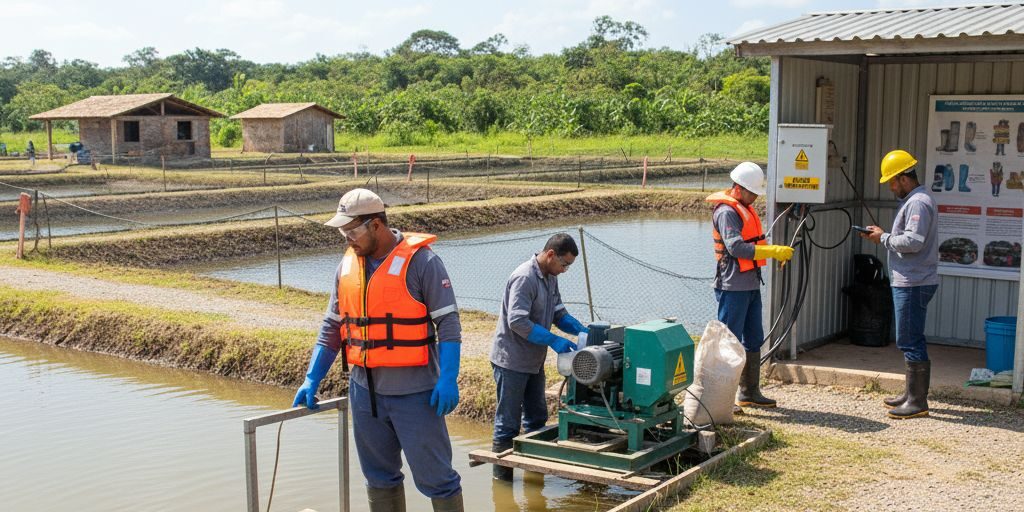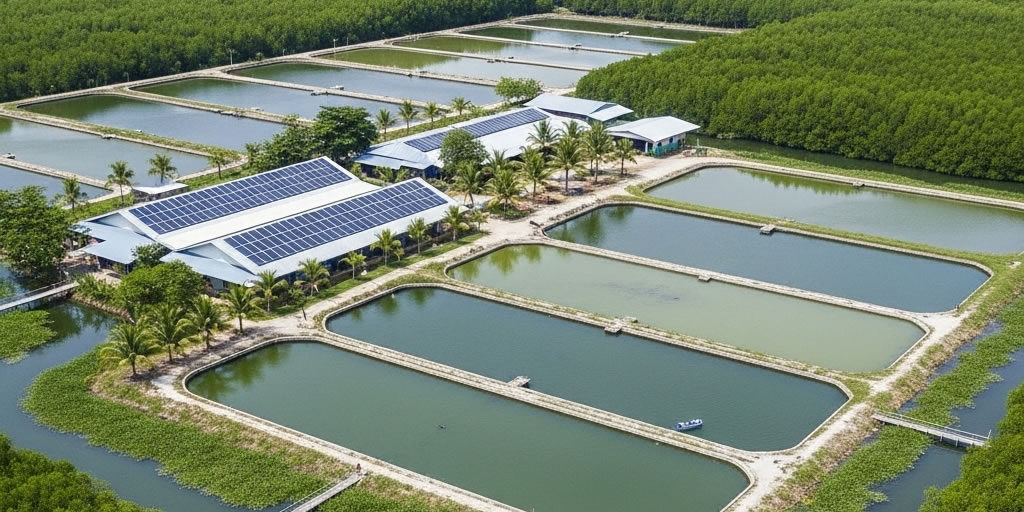- Software Gestor para Aquicultura
- (85) 2139-6730
- contato@despesca.com.br
Occupational Safety Standards in Brazilian Aquaculture

Brazil Rural Credit Guide
19/09/2025
Cooperativism in Aquaculture
23/09/2025Occupational Safety Standards in Brazilian Aquaculture: Protecting Your Team and Avoiding Fines
Brazilian aquaculture is a growing powerhouse; however, production advancements must go hand-in-hand with worker protection. Neglecting Occupational Safety Standards in Brazilian Aquaculture not only puts teams at risk but also exposes businesses to severe financial penalties and interdictions. Consequently, safety management ceases to be a mere legal obligation and becomes a strategic pillar for the farm’s sustainability and efficiency.
Understanding and applying the Regulatory Standards (NRs), which are specific to Brazil, is, therefore, essential for any producer—be it shrimp or fish—aiming for operational excellence. This guide details the main applicable standards in the sector, demonstrating how compliance protects lives and, at the same time, optimizes production processes.
What are Brazil’s Regulatory Standards (NRs)?
Brazil’s Regulatory Standards (Normas Regulamentadoras – NRs), issued by the Ministry of Labor and Employment (Ministério do Trabalho e Emprego), are a set of mandatory technical provisions and procedures. Their primary objective is to guarantee the safety and health of workers in the workplace. In other words, they establish the minimum requirements to prevent accidents and occupational diseases, creating a safer and more productive work environment. For aquaculture in Brazil, several NRs are applicable due to the complexity of daily operations.
Key NRs Applicable to Brazilian Aquaculture
While many standards exist, some have a direct and constant impact on the routines of an aquaculture farm in Brazil. Knowing them is the first step toward effective risk management.
NR 31 – Safety and Health in Rural Work
This is the most crucial standard for the Brazilian rural sector. It covers everything from the handling of agrochemicals and veterinary medicines to safety in the operation of machinery and equipment, such as tractors, aerators, and pumping systems. Furthermore, NR 31 establishes guidelines for ergonomics in handling loads, such as feed bags, and for the safety of electrical installations, which are vital for aeration and pumping systems.
NR 6 – Personal Protective Equipment (PPE)
This standard mandates the employer’s obligation to provide appropriate PPE free of charge for each risk. In Brazilian aquaculture, the list of equipment is varied, including waterproof boots, protective gloves for handling chemicals, safety glasses, sunscreen (considered PPE), life jackets for work on boats or platforms, and respiratory masks against feed dust.
NR 12 – Safety in Machinery and Equipment Operation
This is essential for farms in Brazil that use equipment such as fish graders, filleting machines, or pumps with exposed moving parts. NR 12 requires that these machines have fixed or movable physical guards that prevent operator access to danger zones. Preventive maintenance and operator training are, likewise, crucial aspects of this standard.
NR 33 – Safety and Health in Confined Spaces Work
Although it may seem uncommon, this standard applies to the cleaning and maintenance of storage tanks, cisterns, or feed silos in Brazil. Work in these locations requires an entry permit, continuous atmosphere monitoring, and a rescue team on standby.
NR 35 – Work at Height
Activities such as maintenance on top of a feed silo or on the roofs of sheds are considered work at height (above 2 meters from the lower level) in Brazil. Therefore, NR 35 requires specific planning, operational procedures, and the use of fall protection systems.
Safety Management as a Strategic Tool
Adopting Occupational Safety Standards in Brazilian Aquaculture goes far beyond merely avoiding fines. A well-implemented safety culture results in a more motivated and productive team, as employees feel valued and protected. Consequently, there is a significant reduction in absenteeism rates and costs related to workplace accidents.
Additionally, a farm that demonstrates commitment to the safety and well-being of its team strengthens its image in the market. This factor can be decisive for obtaining quality certifications, which open doors to more demanding and better-paying markets.
How Management Software Assists in Complying with NRs?
Keeping track of all these requirements can be a complex challenge. This is where technology becomes an indispensable ally. Management software, such as Despesca, centralizes information and automates processes that are fundamental for compliance with Brazil’s NRs.
With a management system, it is possible to:
Schedule and Record Maintenance
Create a schedule for preventive maintenance for all machinery and equipment (NR 12), ensuring safe operation and recording all history.
Control PPE Stock
Manage the purchase, distribution to employees, and the expiration or replacement period of protective equipment (NR 6).
Document Training
Maintain detailed records of all safety training conducted, indicating which employees are qualified to operate specific machines or perform specific tasks (NR 31, 33, 35).
Centralize Documentation
Organize reports, licenses, and safety records in a single location, facilitating access during audits and inspections.
In summary, investing in compliance with Occupational Safety Standards in Brazilian Aquaculture is not a cost, but rather a direct investment in the health of your team and the sustainability of your business. By integrating safe practices with modern management tools, producers build a more efficient, profitable, and, above all, humane operation.




